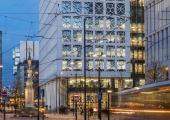April 10, 2013
Productivity challenges of modern office workers’ email deluge
Possibly the most perplexing picture of the modern office is whether technology has made it more, or less productive. New research by Warwick Business School has found that on average UK office workers deal with 40 emails a day and one in 12 with 100 messages a day, which can’t be good for productivity. Meanwhile another piece of research by psychologists at the University of Chester reveals the somewhat unsurprising fact that an over reliance on social media reduces the ability to maintain ‘meaningful’ relationships due to a lack of visual emotional cues – which could further cast doubts over the efficacy of remote working. (more…)





















April 9, 2013
Office design goes to the movies. Part 7 – The Apartment
by Mark Eltringham • Comment, Facilities management, Workplace design
[embedplusvideo height=”151″ width=”220″ standard=”https://www.youtube.com/v/x356ll3hTxg?fs=1″ vars=”ytid=x356ll3hTxg&width=220&height=151&start=&stop=&rs=w&hd=0&autoplay=0&react=1&chapters=¬es=” id=”ep9389″ /]
In which Jack Lemmon exchanges the crushing uniformity of the open plan for a corner office as a reward for allowing senior managers to use his apartment as a venue for their infidelity. This is from 1960, the pre-cubicle, pre-VDU world of large ranks of serried workers in an open plan office with only the privileged few allowed any degree of privacy or the wherewithal to display status. many ways, the layout has much in common with the way many offices are designed now. Office design may have moved on in the past half century but some things are always with us.